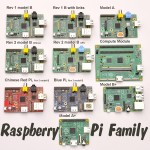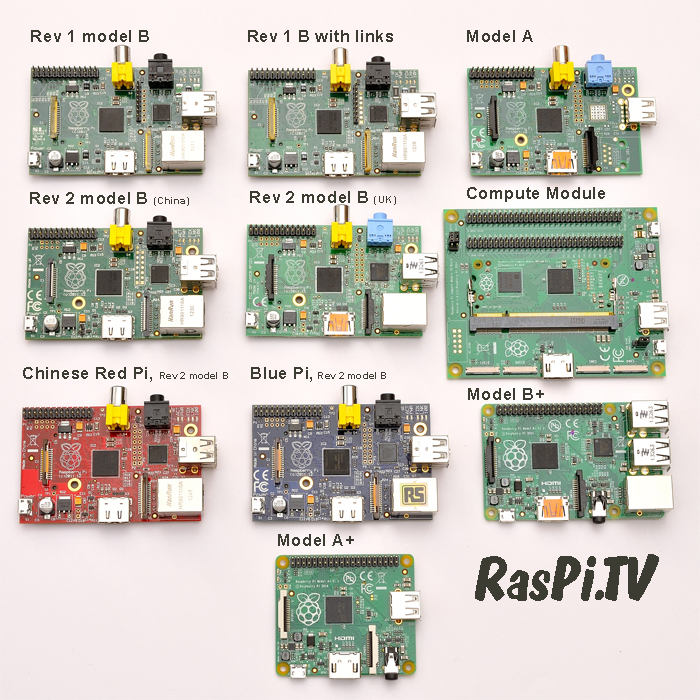
Now we have the A+, I thought it’d be a good time to celebrate its ‘birth’ by having a rundown of the various mass-produced models of Raspberry Pi.
I had a look through my collection and was somewhat surprised to see that I have 10 different variants of Raspberry Pi now. There is one I don’t have, but more about that later. Here’s the family photo. You can click it for a higher resolution version.
Rev 1 Model B
In row 1, column 1 we have the Rev 1 model B. Although I was up early on 29th February 2012, I didn’t get one of the first 10,000 Pis produced. This was delivered in May 2012. It’s a Farnell variant (I have an RS one as well, but it does full-time duty as my weather station). This was the original type of Pi to hit the market. It has 256 Mb RAM and polyfuses on the USB.
Rev 1 Model B – With Links
In row 1, column 2 you’ll see a slightly later variant of Rev 1 model B. This one has 0 Ohm links instead of polyfuses. It helped to overcome some of the voltage drop issues associated with the original Rev 1, but it introduced the “hot-swapping USB devices will now reboot your Pi” issue, which was fixed in the B+.
Rev 2 Model B (China)
Row 2, column 1. Here we have an early Rev 2 Pi. This one was manufactured in China. It originally had a sticker on saying “made in China”, but I took it off. This one was bought some time around October 2012. The Rev 2 model B has 512 Mb RAM (apart from a few early ones which had 256 Mb), mounting holes and two headers called P5 and P6.
Rev 2 Model B (UK)
Row 2, column 2. This is a much later Rev 2 Pi, made at SONY in Wales, UK.
Chinese Red Pi Rev 2 Model B
Row 3, column 1. This is one of the Red Pis made especially for the Chinese market. They are not allowed to be sold in the UK, but if you import one yourself that’s not a problem. It is manufactured to a less stringent spec than the ones at SONY, and is not EMC tested. Therefore it bears no CE/FCC marks.
Limited Edition Blue Pi Rev 2 Model B
Row 3, column 2. I’m not going to go into how I got hold of this. Suffice it to say it was not at all easy, but no laws were broken, and nobody got hurt. RS had 1000 of these made in March 2013 as a special limited anniversary edition to use as prizes and awards to people who’ve made a special contribution to education etc. I know of about 5 or 6 people who have them. (At least two of those people traded for them.) They are extremely hard to get. They come in a presentation box with a certificate. I have #0041. Other than their blueness, they are a Rev 2 model B Pi.
Model A
Row 1, Column 3 is a model A. The PCB is identical to the Rev 2 model B, but it has only one USB port, no ethernet port, no USB/ethernet chip and 256 Mb RAM. The $25 model A was released in February 2013. On the day I got mine, the day after launch, I made a quick and dirty “I’ve got mine first” video, part of which ended up on BBC Click. The model A sold about 100k units. Demand for it was outstripped by the model B, although at one point CPC was offering a brilliant deal on a camera module and model A for £25 (I snagged a couple of those).
Compute Module
Row 2, column 3 is the Compute Module, sitting atop the Compute Module development board. This was launched 23 June 2014 as a way to enable industrial use of the Pi in a more convenient form factor. The module is made so it fits in a SODIMM connector and is essentially the BCM 2835, its 512 Mb RAM and 4 Gb of eMMC flash memory with all available GPIO ports broken out. It costs $30 when bought by the hundred.
Model B+
Row 3, column 3 is the model B+. This was launched on 14 July 2014 and was a major change in form factor. Rounded corners, corner mount holes, 40 GPIO pins, 4 USB ports, improved power circuitry and a complete layout redesign. The B+ was announced as the ‘final revision’ of the B. So it would appear that it’s going to be with us for some time.
Model A+
In row 4, all by itself we have the shiny new Raspberry Pi A+, launched 10 November 2014. It’s essentially the same as a B+ with the USB end cut off. It’s the smallest, lightest, cheapest, and least power-hungry Pi of all so far. It’s 23g, $20 and uses just half a Watt at idle.
So Which One Don’t I Have?
I don’t have a rev 2 256 Mb variant. If you have one and would like to trade or sell it to me, I’d be happy to hear from you (alex AT raspi.tv).
I believe there is also now a red Chinese B+ I’ve not got one of those, but it’s only a matter of time. I wonder if there will be a red A+ at some point too? We Just Don’t Know!

I only have the first and the last
[…] variants of Raspberry Pi he owns and done a nifty review of the differences and features of each. Take a look here. I’m amazed to say I’ve got the only one he hasn’t: a Rev 2 Model B with 256MB […]
Impressive Pokemon-Pi collection! :-) Nice high-res family portrait, good use of composition and lighting.
Just catalogued my own Pi-collection, and it’s not _quite_ as complete as yours (60% of the models pictured).
I also got up early back in Feb 2012, missed out on the first 10,000, and received my first Pi in May 2012. It’s the only Rev1 Model B I have, and also the only Chinese-made Pi I own! When the 512MB Rev2 Model B was released I kicked myself for delaying and not grabbing hold of one of the (now rare) 256MB Rev2 Bs while they were available ;)
The Rev 2 Model B is available in both 2.0 and 2.1 flavours (with slightly tweaked schematics), and I have some of each, all genuinely made in the UK. The Rev2.0 matches your “Rev 2 Model B (China)” picture, and the Rev2.1 matches your “Rev 2 Model B (UK)” picture.
I also have a ComputeModule purchased by itself, and the standalone-CM appears to be identical to the devkit-CM with only some minor silkscreen changes (still labelled as V1.1), and the standalone-CM has gold-plated TestPoints rather than the copper-plated (?) TestPoints on the devkit-CM.
You’re correct that Chinese red B+s exist (I’m told they have a different revision code in ROM) but I’ve never seen one myself. The only blue Pi I’ve seen was in the RPF offices :)
Yeah I can see the Rev 2 B differences now. if you look at the caps below the composite connector, they’re C16 & C17 on the earlier one and C17 & C18 on the later one. I ordered a red B+ this morning (someone found me a link on Ali Express).
I asked Gordon Hollingworth yesterday about the slightly-different-silkscreen on the standalone ComputeModule I have, and apparently it’s a made-in-China version.
Ooooooh. Yet another variant ;p
I have one of the blue and one from the original first batch (i.e. first 10,000) :-)
Is there an indicator, or serial number that will verify the first 10,000? I too woke up in the early hours (I live in Texas, USA) to hit F5 till the page loaded so I could order day one but never tried to figure out if my pi is one of the first.
I have a Revision 1 model B (Rune Audio music server), a Revision 2 model B (UK) (Son’s Minecraft server) and a Model B+ (hope to do some robotics tinkering soon).
Dunno, maybe the first batch of 10,000 have a different PCB manufacture date-code (something like 12XX, where 12 indicates 2012 and XX indicates the week number) ?
Other than that, I don’t think there’s any way of telling?
I’m part of this family, I got 1 Pi B, 2 Pi B+, and keeps growing.
I have two Model B Rev 2 and they are both slightly different that the two that you show.
One of mine is made in China and it actually shows that on the board. The one you show, you said had a sticker saying it was made in China. But, on the board itself it says “Made In The UK”.
My other one shows “Made In The UK” on the board but since it was made to import to the USA it also has the FCC logo on it. The one you show does not have the FCC logo.
I wonder how many other varieties of the boards are out there.
http://elinux.org/RaspberryPi_Boards has a selection of the different variations of the early boards…
Hi Alex
I have 2 early Pi’s 1 from RS and 1 from Farnell
1 has a label on the back E2912RSV1.0B1.1
and the other FN120642017
they look like the “Rev 1 B with links” except for the F1 and F2 (near the USB)
they are green like the “Rev 1 model B”
so witch are mine? or is there a inbetween model?
the best way to find out is to log into the pi and type:
cat /proc/cpuinfoYou should then see something like this…
Processor : ARMv6-compatible processor rev 7 (v6l)BogoMIPS : 697.95
Features : swp half thumb fastmult vfp edsp java tls
CPU implementer : 0x41
CPU architecture: 7
CPU variant : 0x0
CPU part : 0xb76
CPU revision : 7
Hardware : BCM2708
Revision : 000f
Serial : 00000000d298cfc1
Your revision number (second from the bottom) can then be looked up in this table…
http://elinux.org/RPi_HardwareHistory
Theres loads of variation, especially in early Pis with differences in the silkscreen* and/or component substitutions** and/or variations in which holes are filled with solder***.
*AIUI the original RPF gerbers didn’t contain any CE/FCC/WEEE markings so once those approvals were confirmed the contract manufacturers added them, early boards have stickers for those markings instead
** AIUI everything on the Pi except the broadcom SoC and the LAN9514 on the B+ has substitutes available.
*** If a wave solder machine hits an unusued hole (i.e. if the hole wasn’t masked off before wave soldering) it will fill it with solder. IIRC for the JTAG headers it wasn’t specified whether the unused holes were to be kept clear of solders, for the extra GPIO header on the rev 2 it was specified to be clear of solder but some chinese assemblers filled it anyway,
Please put the Picture under CC. Its nice for Wikipedia or like this.
OK done. I’ve put it under CC BY-SA 3.0. Feel free to share away :)
[…] a few weeks ago, when the A+ was launched, I did a ‘family photo’ blog post? In it, I mentioned that I was still missing a 256 Mb Model B rev 2 Pi from September/October 2012. […]
Q. I don’t have a rev 2 256 Mb variant.
A. I have one with the CE logo on the left corner. FN120513412
[…] Back in November 2014 I wrote about the various production revisions of Raspberry Pi. I also published a “family pho…. […]